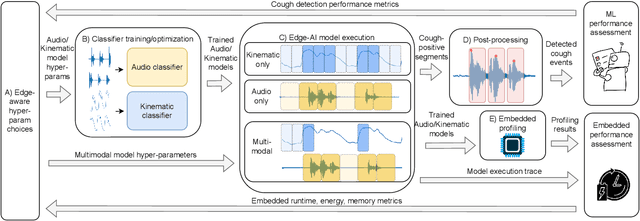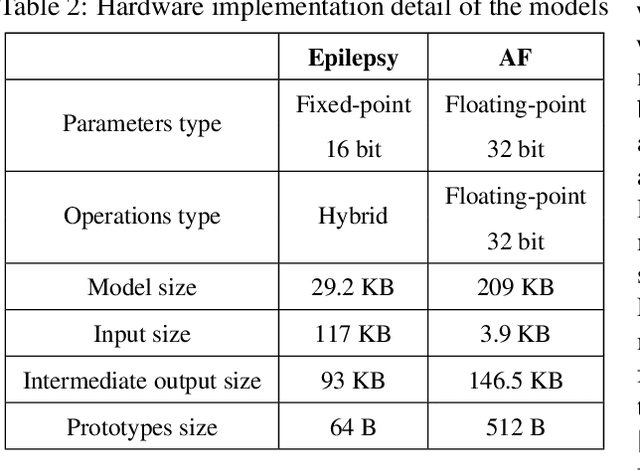Stefano Albini
Enabling Efficient Wearables: An Analysis of Low-Power Microcontrollers for Biomedical Applications
Nov 14, 2024



Abstract:Breakthroughs in ultra-low-power chip technology are transforming biomedical wearables, making it possible to monitor patients in real time with devices operating on mere {\mu}W. Although many studies have examined the power performance of commercial microcontrollers, it remains unclear which ones perform best across diverse application profiles and which hardware features are most crucial for minimizing energy consumption under varying computational loads. Identifying these features for typical wearable applications and understanding their effects on performance and energy efficiency are essential for optimizing deployment strategies and informing future hardware designs. In this work, we conduct an in-depth study of state-of-the-art (SoA) micro-controller units(MCUs) in terms of processing capability and energy efficiency using representative end-to-end SoA wearable applications. We systematically benchmark each platform across three primary application phases: idle, data acquisition, and processing, allowing a holistic assessment of the platform processing capability and overall energy efficiency across varying patient-monitoring application profiles. Our detailed analysis of performance and energy discrepancies across different platforms reveals key strengths and limitations of the current low-power hardware design and pinpoints the strengths and weaknesses of SoA MCUs. We conclude with actionable insights for wearable application designers and hardware engineers, aiming to inform future hardware design improvements and support optimal platform selection for energy-constrained biomedical applications.
Cough-E: A multimodal, privacy-preserving cough detection algorithm for the edge
Oct 31, 2024



Abstract:Continuous cough monitors can greatly aid doctors in home monitoring and treatment of respiratory diseases. Although many algorithms have been proposed, they still face limitations in data privacy and short-term monitoring. Edge-AI offers a promising solution by processing privacy-sensitive data near the source, but challenges arise in deploying resource-intensive algorithms on constrained devices. From a suitable selection of audio and kinematic signals, our methodology aims at the optimal selection of features via Recursive Feature Elimination with Cross-Validation (RFECV), which exploits the explainability of the selected XGB model. Additionally, it analyzes the use of Mel spectrogram features, instead of the more common MFCC. Moreover, a set of hyperparameters for a multimodal implementation of the classifier is explored. Finally, it evaluates the performance based on clinically relevant event-based metrics. We apply our methodology to develop Cough-E, an energy-efficient, multimodal and edge AI cough detection algorithm. It exploits audio and kinematic data in two distinct classifiers, jointly cooperating for a balanced energy and performance trade-off. We demonstrate that our algorithm can be executed in real-time on an ARM Cortex M33 microcontroller. Cough-E achieves a 70.56\% energy saving when compared to the audio-only approach, at the cost of a 1.26\% relative performance drop, resulting in a 0.78 F1-score. Both Cough-E and the edge-aware model optimization methodology are publicly available as open-source code. This approach demonstrates the benefits of the proposed hardware-aware methodology to enable privacy-preserving cough monitors on the edge, paving the way to efficient cough monitoring.
MetaWearS: A Shortcut in Wearable Systems Lifecycle with Only a Few Shots
Aug 04, 2024



Abstract:Wearable systems provide continuous health monitoring and can lead to early detection of potential health issues. However, the lifecycle of wearable systems faces several challenges. First, effective model training for new wearable devices requires substantial labeled data from various subjects collected directly by the wearable. Second, subsequent model updates require further extensive labeled data for retraining. Finally, frequent model updating on the wearable device can decrease the battery life in long-term data monitoring. Addressing these challenges, in this paper, we propose MetaWearS, a meta-learning method to reduce the amount of initial data collection required. Moreover, our approach incorporates a prototypical updating mechanism, simplifying the update process by modifying the class prototype rather than retraining the entire model. We explore the performance of MetaWearS in two case studies, namely, the detection of epileptic seizures and the detection of atrial fibrillation. We show that by fine-tuning with just a few samples, we achieve 70% and 82% AUC for the detection of epileptic seizures and the detection of atrial fibrillation, respectively. Compared to a conventional approach, our proposed method performs better with up to 45% AUC. Furthermore, updating the model with only 16 minutes of additional labeled data increases the AUC by up to 5.3%. Finally, MetaWearS reduces the energy consumption for model updates by 456x and 418x for epileptic seizure and AF detection, respectively.
BiomedBench: A benchmark suite of TinyML biomedical applications for low-power wearables
Jun 06, 2024Abstract:The design of low-power wearables for the biomedical domain has received a lot of attention in recent decades, as technological advances in chip manufacturing have allowed real-time monitoring of patients using low-complexity ML within the mW range. Despite advances in application and hardware design research, the domain lacks a systematic approach to hardware evaluation. In this work, we propose BiomedBench, a new benchmark suite composed of complete end-to-end TinyML biomedical applications for real-time monitoring of patients using wearable devices. Each application presents different requirements during typical signal acquisition and processing phases, including varying computational workloads and relations between active and idle times. Furthermore, our evaluation of five state-of-the-art low-power platforms in terms of energy efficiency shows that modern platforms cannot effectively target all types of biomedical applications. BiomedBench will be released as an open-source suite to enable future improvements in the entire domain of bioengineering systems and TinyML application design.
 Add to Chrome
Add to Chrome Add to Firefox
Add to Firefox Add to Edge
Add to Edge